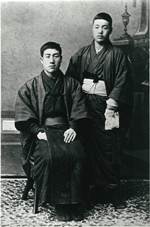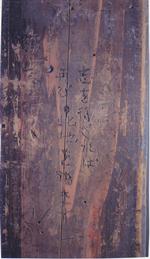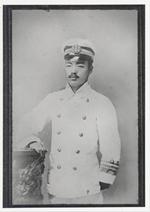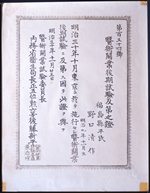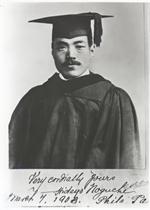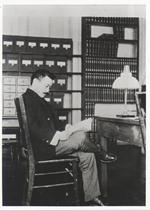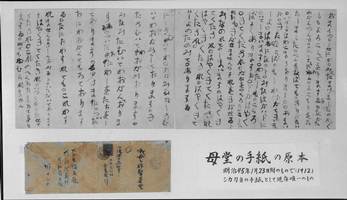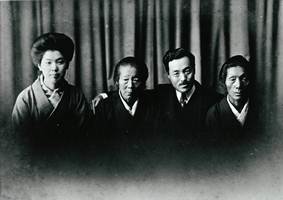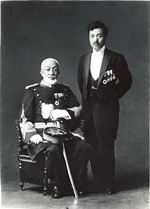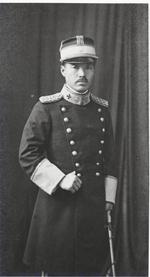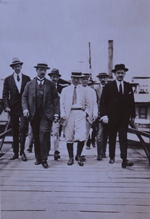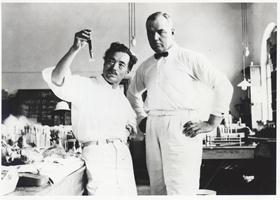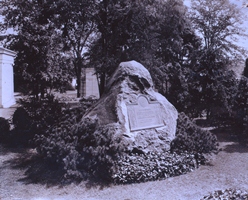Life History of Hideyo Noguchi
|
Year |
Age |
|
|
|
1876 |
|
Born in Inawashiro in Fukushima on November 9 (childhood name: Seisaku) |
Hideyo Noguchi's birth and his childhood He suffered a serious burn on his left hand when he fell onto a fireplace at the age of one and half. He got excellent grades at elementary school with his hard work. He underwent an operation on his left hand by Dr. Kanae Watanabe with support from teachers and friends when he was in Inawashiro Elementary School. Because of this operation, he determined to be a doctor and became a medical student of Kaiyo Hospital in Wakamatsu. He worked hard day and night to prepare for the National Medical Practitioners Qualifying Examination.
Left: Photographed after receiving an operation on his left hand. |
|
1878 |
2 |
Suffers a burn to his left hand upon falling onto a fireplace at home in late April |
|
|
1883 |
7 |
Enters Mitsuwa Elementary School |
|
|
1884 |
8 |
Undergoes an operation on his left hand by Dr. Yukimoto Saito |
|
|
1887 |
11 |
Transfers to the fourth grade of the ordinary course of elementary school in April |
|
|
1888 |
12 |
Enters the supplementary course of elementary school in April and becomes the student president |
|
|
|
|
Experiences an eruption of Mt. Bandai on July 15 |
|
|
|
|
Enters Inawashiro Higher Elementary School in April |
|
|
1892 |
16 |
Undergoes an operation on his left hand by Dr. Kanae Watanabe, head doctor of Kaiyo Hospital in Aizuwakamatsu City in October |
|
|
1893 |
17 |
Graduates from Inawashiro Higher Elementary School with honors in March |
|
|
|
|
Joins Kaiyo Hospital in May as a medical student and learns medical science, English and French |
|
|
1896 |
20 |
Comes to Tokyo in September to take the National Medical Practitioners Qualifying Examination |
Time in Tokyo After he became a medical doctor, he worked at Takayama Dental Hospital, Juntendo Hospital, Kitasato Institute and Yokohama Port Quarantine Station. He changed his name "Seisaku" to "Hideyo" at this time. After he was highly evaluated for discovering a plague patient at the quarantine station, he was dispatched to Newchwang, China, as a member of the International Sanitary Board and worked as a health officer. Being good at English and Chinese, he was so appreciated by the local people that they asked him to stay longer. Left: Hideyo in a quarantine medical officer uniform |
|
|
|
Passes the first half of the medical exam in October |
|
|
|
|
Becomes a working student at Takayama Dental School in November with the support of Dr. Morinosuke Chiwaki |
|
|
1897 |
21 |
Enters Saiseigakusha medical school in May, and undergoes an operation on his left hand again by Dr. Tsugisige Kondo, Tokyo Imperial University, with the support of Dr. Chiwaki | |
|
|
|
Passes the second half of the exam in October and obtains a medical license |
|
|
|
|
Becomes a lecturer at Takayama Dental School in October |
|
|
|
|
Begins to work at Juntendo Hospital in November |
|
|
1898 |
22 |
Renames himself "Hideyo" when he returns to his hometown in August |
|
|
|
|
Becomes an assistant at Kitasato Institute for Infectious Diseases in October |
|
|
1899 |
23 |
Serves as a guide and an interpreter for Dr. Simon Flexner during his visit to Tokyo in April |
|
|
|
|
Begins to work at Yokohama Port Quarantine Station as a quarantine medical officer in May |
|
|
|
|
Begins to work at Central Hospital of Newchwang, China under the International Sanitary Board in October |
|
|
1900 |
24 |
Departs from Yokohama, Japan for the United States on December 5 |
Early period of his stay in the United States When the Rockefeller Institute for Medical Research was established, Dr. Flexner was appointed as the director. He employed Hideyo as an assistant at the Institute. Hideyo was nominated for the Nobel Prize for his study of syphilis spirochete and achieved worldwide acclaim. He worked on many studies as a member of the Rockefeller Institute. Left: Hideyo in an academic gown |
|
|
|
Arrives at Philadelphia on December 30, and visits Dr. Flexner at the University of Pennsylvania |
|
|
1901 |
25 |
Becomes an assistant of Dr. Flexner and engages himself in the study of snake venoms |
|
|
|
|
Presents a paper on snake venoms at the National Academy of Sciences in November |
|
|
1902 |
26 |
Becomes a pathology assistant at the University of Pennsylvania in October |
|
|
1903 |
27 |
Becomes a research assistant at the Carnegie Institution of Washington in October, and goes to study in Denmark |
|
|
|
|
Learns at Statens Serum Institut under the instruction of Dr. Thorvald Madsen |
|
|
1904 |
28 |
Becomes an assistant at Rockefeller Institute for Medical Research in October |
|
|
1907 |
31 |
Awarded a master's degree in science by the University of Pennsylvania in June |
|
|
1909 |
33 |
Publishes the book Snake Venoms from the Carnegie Institution of Washington |
|
|
1910 |
34 |
Publishes the book Serum Diagnosis of Syphilis and the Butyric Acid Test for Syphilis |
|
|
1911 |
35 |
Awarded a medical doctor's degree by Kyoto Imperial University in February |
|
|
|
|
Succeeds in growing a pure culture of syphilis spirochete |
|
|
|
|
Marries Mary Dardis in April |
|
|
1912 |
36 |
Receives a letter from his mother, Shika Noguchi, urging him to return to Japan |
A letter from his mother It was three years later when he could finally return to Japan to see his mother because he had engagements of many studies and lectures at the time.
|
|
1913 |
36 |
Discovers Treponema pallidum in the brain tissues of patients suffering from general paresis |
|
|
|
|
Goes on a lecture tour in Europe in September, and receives medals from the King of Spain and the King of Denmark |
|
|
1914 |
38 |
Awarded a doctorate of science by Tokyo Imperial University in April |
|
|
|
|
Promoted to full member of the Rockefeller Institute in July |
|
|
|
|
Nominated for the Nobel Prize |
|
|
1915 |
39 |
Awarded the Imperial Prize from the Imperial Academy in April |
|
|
|
|
Nominated for the Nobel Prize again |
|
|
|
|
Returns to Japan after fifteen years on September 5. Decorated for Kun Yonto (Fourth Class of Order), and attends lecture meetings and banquets. Takes trips to Tokyo and Kansai areas with his mother . |
Returning to Japan after fifteen years away |
|
|
|
Leaves for the United States again from Yokohama on November 4 |
|
|
1918 |
42 |
Dispatched to Guayaquil, Ecuador in June, and discovers the pathogen of yellow fever on the ninth day |
Later period of his stay in the United States The Rockefeller Institute for Medical Research made a plan to send a research team to Latin America to investigate a raging yellow fever epidemic and called Hideyo for the team. First, he went to Ecuador. He found the pathogen of yellow fever only nine days after his arrival, and made serum and vaccine, which saved may lives and were appreciated by local people. However, some researchers held doubts about his discovery of the pathogen.
Left: Hideyo in an honorary medical officer's uniform |
|
|
|
His mother passes away at the age of 65 |
|
|
1919 |
43 |
Publishes a paper on the pathogen of yellow fever |
|
|
|
|
Sent to Mexico to study yellow fever in December | |
|
1920 |
44 |
Dispatched to Peru in April | |
|
|
|
Dispatched to Mérida, Mexico in November |
|
|
|
|
Nominated for the Nobel Prize |
|
|
1922 |
46 |
Dr. Morinosuke Chiwaki visits the United States in May to research U.S. and European dentistry |
|
|
1923 |
47 |
His father passes away at the age of 71 on July 3 |
|
|
|
|
Becomes a member of the Imperial Academy in November |
|
|
|
|
Dispatched to Brazil in November to study yellow fever | |
|
1924 |
48 |
Attends a conference on tropical diseases in Kingston, Jamaica in July |
|
|
1925 |
49 |
Conferred the court rank of Shougoi (senior fifth rank) on November 15 |
|
|
1926 |
50 |
Publishes a paper on the etiology of Oroya fever |
|
|
1927 |
51 |
Publishes a paper on the etiology of trachoma |
|
|
|
|
Dispatched to Africa in October to study yellow fever |
Death during his study of yellow fever in Africa Using more than 400 laboratory monkeys, and extending his originally planned three-month stay to six months, he continued his study on yellow fever. Just when he got some ideas about the cause of yellow fever and was about to leave Africa, he was infected with yellow fever himself and died ten days later. His death was reported all over the world and people were engulfed by grief.
|
|
1928 |
52 |
Suffers from yellow fever during his research of the disease in Accra, Ghana, and passes away on May 21 at the age of 51 |
|
|
|
|
Awarded Kun Nito (Second Class of Order) and receives the Order of the Rising Sun, Gold and Silver Star |
|
|
|
|
Laid to rest at Woodlawn Cemetery in Bronx, New York on June 15 |
Life history chart provided by The Hideyo Noguchi Memorial Association
English translation by Hideyo Noguchi Africa Prize Unit

